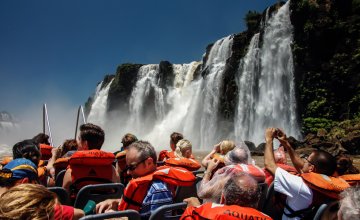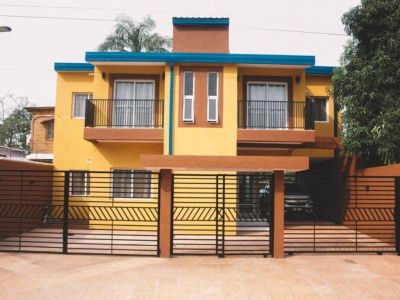Standing in front of them, one tries even to speak "esperanto" to define them desperately, creating a new language to describe them. After a while, we realise that Iguazú Falls can only be described in the soul and we come to our senses. Through images and sounds, we try to capture part of that enchantment that we would like to keep till the last day in our lives. Sensations, they were kept in ourselves as we visited one of the most spectacular places in the world. Currently, being completely renewed, Iguazú National Park, started a new concept of ecologic tourism, providing with an infrastructure of services which is appropriate to the demands of International Tourism. All these, provided that the landscapes surrounding are preserved, that is why it was declared Natural Patrimony of Humanity.
During our stay in the Park, we could go along modern footbridges in the most imposing falls of the place. Admiration and contemplation without a break, added to the end of the day with us completely exhausted, are some of the sensations we kept as we left the natural park. The area where Iguazú Falls are situated is an environment which is humid, with average temperatures of 15º C in Winter and 30º C in Summer. Due to this fact, it is not advisable to take electronic elements such as video cameras or digital cameras since both, the climate and the falls spray can be harmful for these appliances. The undisputed protagonist of the area is Iguazú River which is 1300 kilometers long until its outlet in Paraná River located 23 kilometers ahead of the spectacle that amazes tourists. We advise you to be careful as you go along footbridges, especially when they have humid uneven platforms - they can be slippery. Wanting to walk and to connect with the environment, we were fascinated with "Garganta del Diablo"- the biggest fall which pours 3 million cubic meters per minute forming fresh fumaroles of dew and vapour which can sometimes be seen from a 5 kilometer-distance. We also went through the upper circuit where we admired the legendary falls called San Martín, El Escondido, Dos Mosqueteros, Rivadavia, Peñón, Mitre, Mbigua, Dos Hermanas, Chico Alférez, Bernabé Méndez and Bossetti, with hights ranging from 40 to 80 meters and where an eternal dew depicts a rainbow of exquisite contrast with the scenery. It is important to highlight that Bernabé Méndez Fall was named after a Forest Ranger who was killed by poacher hunters in High Iguazú in 1968 when he was defending the Natural Patrimony of Humanity. From vantage points, one can observe San Martín Isle and part of the
Brazilian side of the Falls. After a while contemplating, we carefully went down to the footbridges at the bottom to sharpen our senses- this time from a different perspective. Thus, we found Álvar Núñez and Lanusse Falls. As one finishes the tour, one can cross Iguazú River in a boat to San Martín Isle or go on different boat excursions in front of the waterfalls. In San Martín Isle, located in the very heart of the park, one can be in contact with exuberant forest vegetation full of tree ferns, palm trees, orchids, air carnations and palo rosa- the last considered National Monument. From there, you get a spectacular view of San Martín Fall and de La Ventana Rock, a considerable rock formation located in between the falls. Boat excursions deserve a special chapter since, in them adrenalin, speed and water get together to launch gusts of dizziness. Along the tour, we come across coaties, tapirs, guinea pigs, capybaras, parrots, hummingbirds, tucans, butterflies and a great amount of alligators and lizards that make up the rich fauna of the region. Iguazú - meaning "big waters" in Guaraní- is a real wonder of nature. -
Upper Circuit: provides you with magnificent panoramic views of the Falls and of Iguazú River Delta which makes up a group of isles or islands. There are no stairs. Lasts: 1 hour 15 minutes. -
Green Path: a walk through the forest where you can observe autochthonous birds, reptiles, butterflies and a bath in the very forest. There are no stairs. Lasts: 20 minutes. -
Lower Circuit: it is a group of footbridges which are strategically designed to observe the Waterfalls with different perspectives. Difficulty: there are stairs. Lasts: 1 hour 15 minutes. -
San Martín Isle: located in the very heart of Cataratas and offers spectacular views of the 275 falls that belong to the National Park. Difficulty: steep stairs. Lasts: 2 hours.
Marcelo Sola
Eduardo Epifanio
Phone: +54 3757-421008
Phone: +54 3757-491469
Phone: +54 3757-491040







































